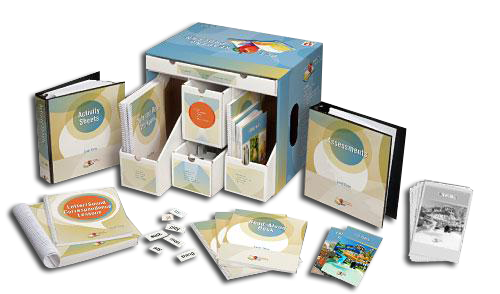PCI Reading Program Level Three is designed to move students toward reading independence by using the words taught in Levels One and Two as exemplars for teaching 23 onsets and 20 word families. Students learn the basics of word analysis, word building, and decoding in a uniquely scaffolded introduction to phonics that expands the success based, controlled-vocabulary approach from Levels One and Two. In addition, Level Three introduces students to the new genres of nonfiction and poetry and seamlessly integrates comprehension, writing, and fluency skills into the lesson cycle.
Unique Approach to Phonics:
Level Three serves as a bridge between the whole-word visual discrimination approach in Levels One and Two and the decoding required of independent readers. To promote student success, instruction is carefully scaffolded to introduce students to the process of decoding by unveiling sounds that are embedded within the sight words they already know how to read. Students learn to examine known sight words, recognize common onsets and rimes, match phoneme sounds to letters, and decode unfamiliar words such as “bat” and “rake.”
A Wide Array of Manipulatives:
The program comes with a magnet board and 363 magnets to make building words easy and fun. Five different types of magnets are included: onsets, rimes, words, inflectional endings, and word family labels. In addition, word strips and word windows allow students to practice building new words in a word family and reading with fluency. Level Three also includes Match on the Mat text and scene cards for additional reading and comprehension practice.
More Reading Opportunities:
The program’s 20 books alternate between nonfiction and fiction, and each nonfiction book shares a theme or topic with the fiction book that follows it. Fiction books have a variety of outstanding illustrators and feature middle school- and high school-age students in contemporary settings. Nonfiction books feature beautiful full-color photos and offer a range of topics that include social studies and science themes. Many of the nonfiction books also include features such as charts, diagrams, or timelines. Additional opportunities to read sentences and paragraphs are provided by the read-alouds, activity sheets, and Match on the Mat cards.
Flexible Implementation:
Level Three has been designed for maximum flexibility and individualization of instruction. Onset instruction is provided in the Letter/Sound Correspondence Lessons book, and rime instruction is included in the Core Instruction Guide. Teachers may choose to teach all 23 onsets and then begin Unit 1 of the Core Instruction Guide, or they may choose to start at Unit 1 and assess students only on the onsets they will use to build words in that unit. In this case, onset instruction would be limited to only the initial sounds that students will use in Unit 1 but don’t already know.
Level Three Lesson Cycle:
Level Three includes a layered lesson cycle to integrate phonics, comprehension, fluency, and writing into a seamless system of instruction. Within each unit, there are five lessons. The first three focus on phonics, teaching one of the rimes and moving from the known sight words in that word family to new decodable words in that pattern.
The last two lessons in each unit focus on compre-hension, using the book developed for that unit. These two lessons move from a focus on literal comprehension to explicit teaching of higher-order comprehension skills.
Lesson 1 - Introduce rime from known words
Lesson 2 - Build new decodable words using the rime
Lesson 3 - Practice reading/applying new decodable words
Lesson 4 - Explicit comprehension instruction and literal comprehension of unit book.
Comprehension, Fluency and Writing Instruction:
In Level Three, students mature as both readers and writers, learning and applying higher-order compre-hension skills as well as practicing fluency and writing. Comprehension skills, including setting, main idea, and cause and effect, were selected based on an analysis of the types of questions on alternative state assessments. Unit tests include both decoding and comprehension questions, allowing teachers to monitor all aspects of reading progress. Writing opportunities are provided through the Write and Read Workbook, and fluency activities and assessments are integrated into each unit.
- Core Instruction Guide
- Letter/Sound Correspondence Lessons
- Read-Aloud Book
- Write and Read Workbook (5 copies)
- Activity Sheets Binder
- 20 Student Books
- Magnet Board
- 363 Magnets
- 125 Picture Cards
- Match on the Mat Board
- 100 Match on the Mat Cards
- 20 Word Windows and 40 Word Strips
- Plastic Viewer
- Assessments Binder
- Teacher’s Guide
(PCI-RP3) PCI Reading Program - Level Three
PCI-RP3 Complete Kit Includes:
Target Group: Students who have completed Level Two



